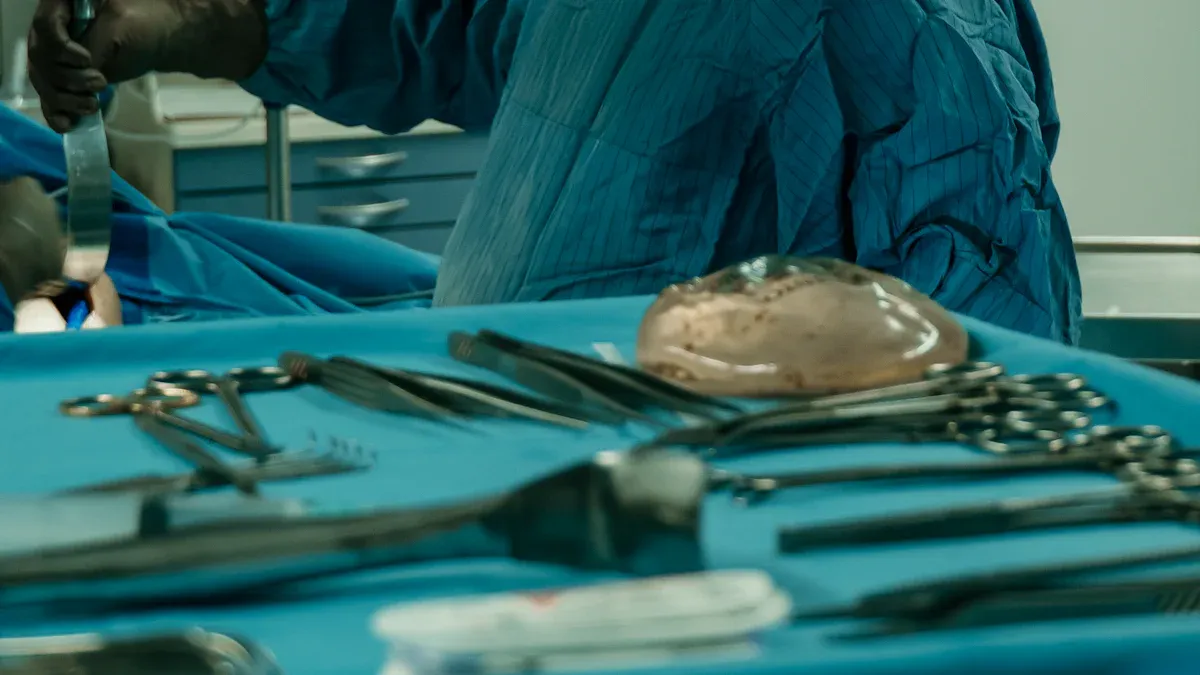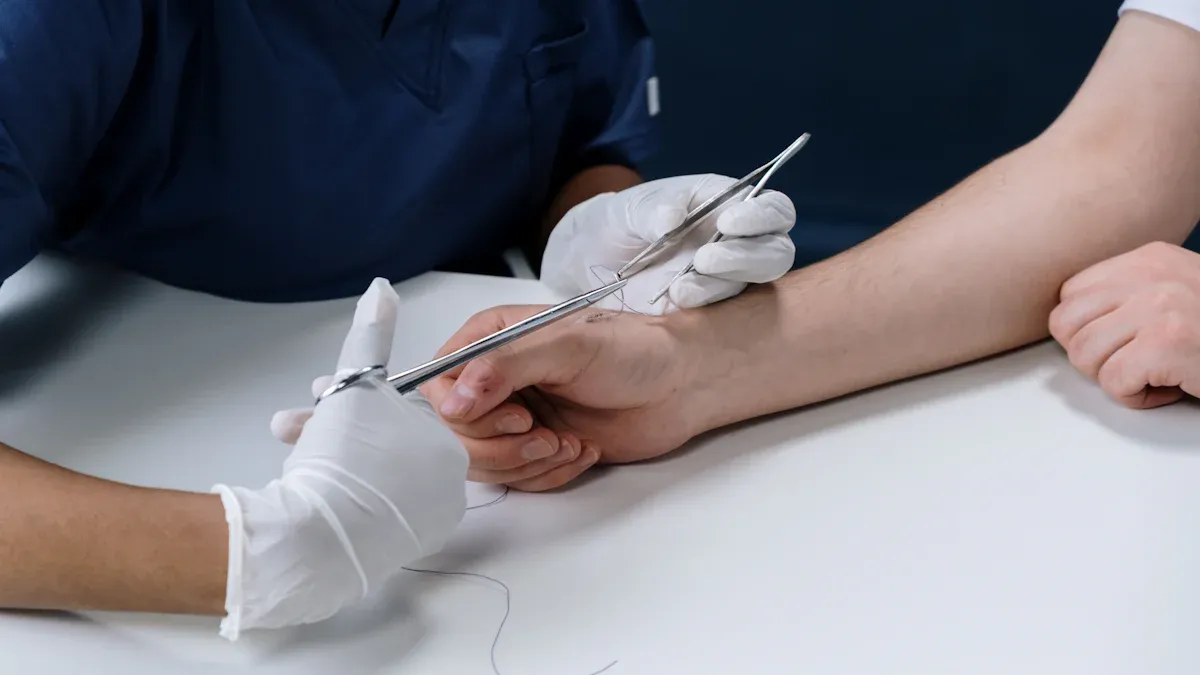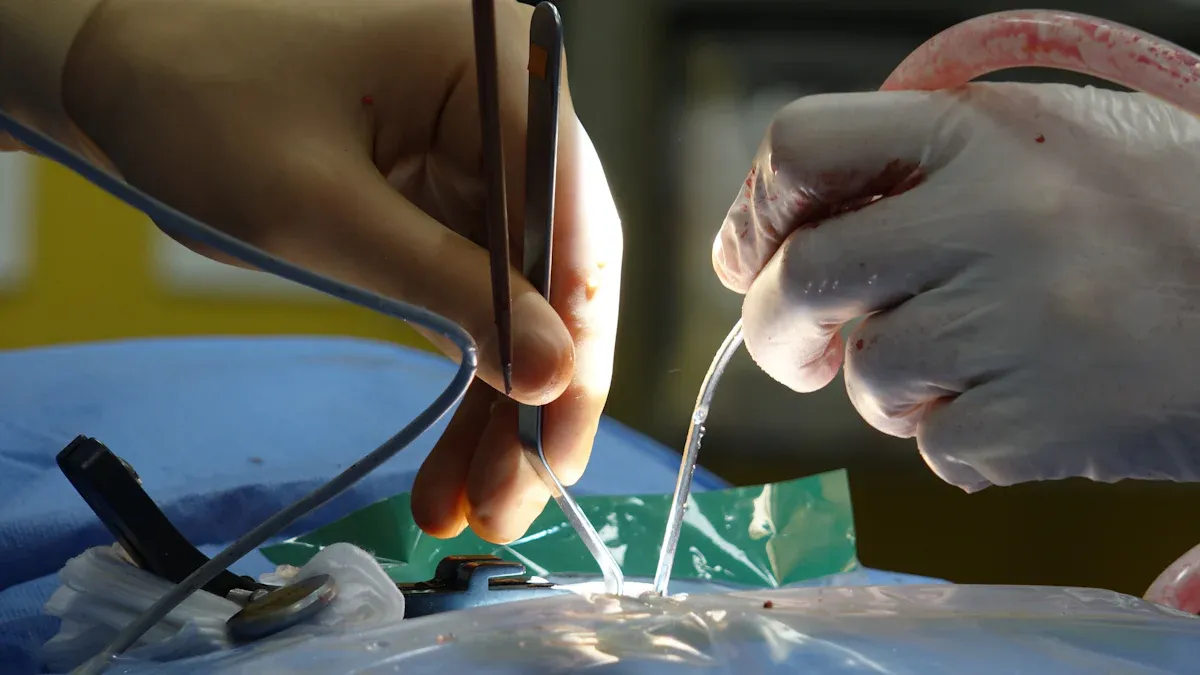How Customizable Nitinol Stent Tubing Enhances Neurosurgical Precision

Customizable nitinol stent tubing for neurosurgery has become a cornerstone of innovation in modern medicine. Its ability to adapt to intricate neurovascular structures has made it indispensable for addressing complex surgical challenges. Studies highlight its role in advancing minimally invasive procedures, enabling safer and more effective interventions. For example:
Neurointerventional devices have driven significant progress in minimally invasive neurosurgery.
Pilot studies in both animals and humans have demonstrated the feasibility of interventional tools for electrode delivery.
The Stentrode, a nitinol-based device, has successfully recorded and stimulated vascular electrocorticography (ECoG) in animal models and is undergoing clinical trials for motor neuroprostheses.
These developments underscore the unmatched potential of customizable nitinol stent tubing for neurosurgery in transforming patient outcomes.
Key Takeaways
Flexible nitinol stent tubing fits tricky brain blood vessels better.
Nitinol can bend and return to its shape, making it safe.
Changing size and thickness helps stents work well for each case.
Special methods like cutting with lasers make stents stronger.
Picking trusted makers, like AccuPath, ensures safe, top-quality tubing.
Unique Properties of Nitinol

Nitinol stands out as a material of choice for neurosurgical applications due to its remarkable properties. These unique characteristics enable it to meet the demanding requirements of neurovascular procedures, ensuring precision, safety, and long-term performance.
Superelasticity and Shape Memory
Nitinol exhibits two defining properties: superelasticity and shape memory. Superelasticity occurs when the material undergoes stress-induced martensite transformation (SIM), allowing it to deform significantly and return to its original shape once the stress is removed. This behavior is particularly advantageous in neurovascular stents, where the ability to conform to intricate arterial geometries is critical. Shape memory, on the other hand, is linked to thermoelastic martensitic transformation (TMT). When exposed to specific temperature variations, nitinol can transition between its austenite and martensite phases, enabling it to "remember" and revert to a pre-set shape.
These properties make nitinol highly adaptable for neurovascular applications. For instance, stents made from nitinol can be compressed for insertion and then expand to their intended shape upon deployment. This adaptability reduces the risk of complications and enhances procedural outcomes. Research further supports these capabilities, highlighting nitinol's ability to maintain structural integrity while navigating complex anatomical pathways.
Property | Description |
|---|---|
Superelasticity | Occurs through stress-induced martensite transformation (SIM) when characteristic stresses are applied. |
Shape Memory Effect (SME) | Linked to thermoelastic martensitic transformation (TMT) triggered by temperature variations. |
Phase Transformation | Involves reversible transitions between austenite (A) and martensite (M) phases under specific conditions. |
Biocompatibility and Corrosion Resistance
Biocompatibility for neurovascular applications is a critical requirement, and nitinol excels in this area. Its surface properties ensure compatibility with human tissues, minimizing the risk of adverse reactions such as thrombosis or inflammation. In vitro studies have demonstrated that nitinol stents perform effectively in curved artery models without significant mechanical issues. Similarly, in vivo studies in swine models have shown no abnormalities or thrombosis, further validating its safety and reliability.
Corrosion resistance is another key advantage of nitinol. The material forms a protective oxide layer that shields it from degradation in the body's harsh environment. This resistance ensures the long-term stability of nitinol implants, making them suitable for extended use in neurovascular procedures. These attributes collectively enhance patient safety and contribute to the material's growing adoption in neurosurgery.
Key Findings:
In vitro studies: No significant mechanical issues in curved artery models.
In vivo studies: No thrombosis or abnormalities in swine models.
Protective oxide layer: Ensures long-term corrosion resistance.
Durability and Stress Performance
Durability is a hallmark of nitinol, making it ideal for high-stress environments like the neurovascular system. The material's fatigue resistance allows it to endure millions of cycles of stress and strain without failure. For example, nitinol implants around the heart can withstand over 400 million fatigue cycles, while those in other areas endure up to 100 million cycles. Accelerated fatigue testing has confirmed its reliability under real-world conditions, ensuring that nitinol devices maintain their performance over time.
Pre-processing steps, such as low-temperature aging, further enhance nitinol's fatigue life. These measures improve the material's ability to withstand repetitive loading, a critical factor in neurosurgical applications. By combining durability with stress performance, nitinol ensures the longevity and effectiveness of neurovascular stents, reducing the likelihood of complications and the need for repeat interventions.
Evidence Description | Details |
|---|---|
Low-temperature aging effects on fatigue life | Improvements in Nitinol fatigue life under certain circumstances due to pre-processing steps. |
Accelerated fatigue testing methodology | Testing under loading conditions representative of clinical scenarios for market approval. |
Fatigue cycles experienced by Nitinol implants | Devices around the heart can experience over 400 million cycles, while others may see up to 100 million cycles. |
Customization for Neurovascular Applications
Customization for neurovascular applications plays a pivotal role in enhancing the performance and reliability of nitinol stent tubing. By tailoring dimensions, employing advanced manufacturing techniques, and refining surface finishes, manufacturers can meet the unique demands of neurovascular procedures. These customizations ensure that nitinol devices deliver optimal functionality, safety, and durability.
Dimensional Customization: Diameter, Wall Thickness, and Length
Dimensional customization is essential for ensuring that nitinol stent tubing meets the precise requirements of neurovascular applications. Adjustments to diameter, wall thickness, and length allow for compatibility with intricate anatomical structures and medical-grade devices.
Diameter: The diameter of nitinol tubing is critical for its functionality. Precise tolerances ensure compatibility with neurovascular devices, reducing the risk of procedural complications. Industry standards dictate these tolerances to guarantee reliability.
Wall Thickness: Wall thickness directly impacts the strength, flexibility, and fatigue resistance of nitinol stents. Customizing this aspect ensures consistent performance under the dynamic stresses of the neurovascular system.
Length: Customizable lengths optimize the performance and safety of nitinol devices. This flexibility allows manufacturers to tailor stents for diverse neurovascular applications, addressing specific procedural needs.
Understanding material properties and dimensional precision is crucial for reliable performance in critical applications. Nitinol's unique characteristics necessitate rigorous testing and precise manufacturing to ensure safety and effectiveness. Dimensional checks confirm compliance with stringent medical standards, making them indispensable for neurovascular procedures.
Dimensional Aspect | Benefits |
|---|---|
Diameter | Ensures compatibility with medical-grade components and devices. |
Wall Thickness | Enhances strength, flexibility, and fatigue resistance. |
Length | Optimizes performance and safety for diverse neurovascular applications. |
Advanced Manufacturing Techniques: Laser Cutting and Heat Treatment
Advanced manufacturing techniques like laser cutting and heat treatment enable the precise fabrication of nitinol stent tubing. These methods enhance the material's structural integrity and adaptability, making it suitable for complex neurovascular applications.
Laser Cutting: Laser cutting provides unparalleled precision in shaping nitinol tubing. This technique allows for intricate designs, ensuring that stents can navigate the complex geometries of the neurovascular system. The process minimizes material waste while maintaining the structural integrity of the tubing.
Heat Treatment: Heat treatment optimizes the mechanical properties of nitinol by altering its phase transformation temperatures. For instance, low-temperature treatments reduce dislocation density and form precipitates, while higher temperatures promote recrystallization and dissolve precipitates. These adjustments enhance the material's durability and flexibility, ensuring long-term performance.
Techniques like X-ray diffraction (XRD) and Electronic Speckle Pattern Interferometry-Hole Drilling (ESPI-HD) evaluate stress levels in nitinol. These evaluations confirm the reliability and durability of nitinol devices, ensuring their suitability for neurovascular applications.
Heat Treatment Temperature (°C) | Transformation Temperature (°C) | Observations |
|---|---|---|
Below 600 | Increased with heat treatment | Reduced dislocation density and formation of precipitates. |
Above 600 | Decreased with heat treatment | Recrystallization completed, precipitates started to dissolve. |
400 | B2 → B19 transformation observed | Low heat treatment temperature sufficient for transformation. |
800 | B19 ↔ B19′ transformation detected | Higher temperature required for transformation after recrystallization. |
Surface Finishes: Polishing, Coating, and Texturing
Surface finishes significantly influence the performance and biocompatibility of nitinol stent tubing. Polishing, coating, and texturing enhance the material's interaction with surrounding tissues, reducing the risk of complications.
Polishing: Polishing creates a smooth surface, minimizing friction during device deployment. This finish also reduces the likelihood of thrombosis by preventing irregularities that could trigger clot formation.
Coating: Coatings improve the biocompatibility of nitinol stents. For example, hydrophilic coatings enhance lubricity, facilitating easier navigation through neurovascular pathways. Drug-eluting coatings can also be applied to deliver therapeutic agents directly to the target site.
Texturing: Textured surfaces promote better integration with surrounding tissues. This customization improves the stability of the stent, reducing the risk of migration or displacement.
By refining surface finishes, manufacturers can address specific procedural challenges, ensuring that nitinol stents perform reliably in diverse neurovascular scenarios.
Benefits of Customizable Nitinol Stent Tubing for Neurosurgery

Flexibility for Navigating Complex Anatomies
Customizable nitinol stent tubing offers unparalleled flexibility, making it ideal for navigating the intricate pathways of the neurovascular system. Neurovascular stents must adapt to the unique geometries of arteries and veins, which often feature sharp curves and narrow passages. Nitinol's superelasticity allows these stents to conform seamlessly to these complex structures without compromising their integrity. This flexibility minimizes the risk of arterial damage during deployment and ensures precise placement, even in challenging anatomical regions.
The customization of nitinol stents further enhances their performance. Adjustments to dimensions, such as diameter and wall thickness, ensure compatibility with specific neurovascular anatomies. This tailored approach reduces procedural complications and improves patient outcomes. By combining material properties with precise customization, nitinol stents provide a reliable solution for complex neurovascular challenges.
Adaptability to Dynamic Physiological Conditions
Nitinol's adaptability to dynamic physiological conditions sets it apart from other materials used in neurovascular stents. The material's shape memory and pseudoelasticity enable it to maintain its functionality under varying stresses and strains. For instance, nitinol stents can expand and contract in response to changes in blood flow or vessel diameter, ensuring consistent performance over time.
Engineering tests validate this adaptability. Accelerated durability testing evaluates the fatigue life of nitinol stents under physiological loading conditions, confirming their reliability. Modeled stent sizes and stress analyses further demonstrate their ability to withstand dynamic environments. Additionally, surface finishes play a crucial role in enhancing nitinol's performance. Studies show that corrosion resistance varies with surface finish, emphasizing the importance of polishing and coating in improving the longevity of neurovascular stents.
Recommendation | Description |
|---|---|
Modeled Stent Sizes | Analyze worst-case fatigue life for stent sizes. |
Inputs and Assumptions | Use mean and alternating stresses/strains for fatigue life. |
Accelerated Durability Testing | Validate fatigue analysis under physiological conditions. |
Long-Term Durability and Reduced Risk of Complications
The durability of nitinol stents ensures their long-term effectiveness in neurovascular applications. These stents can endure millions of stress cycles without failure, making them suitable for high-stress environments like the neurovascular system. Pre-processing techniques, such as heat treatment, enhance nitinol's fatigue resistance, further extending its lifespan.
By reducing the risk of mechanical failure, nitinol stents lower the likelihood of complications such as stent migration or fracture. Their biocompatibility also minimizes adverse reactions, ensuring patient safety. Customization plays a vital role in achieving these outcomes. Tailored dimensions and surface finishes optimize the performance of nitinol stents, addressing specific procedural needs and improving overall reliability.
The combination of durability, adaptability, and customization makes nitinol stent tubing an indispensable tool in neurosurgery. Its ability to meet the demands of dynamic physiological conditions while maintaining long-term performance highlights its value in advancing neurovascular interventions.
Choosing the Right Supplier for Nitinol Tubing
Medical-Grade Expertise and Industry Standards
Selecting a supplier for nitinol tubing requires careful evaluation of their medical-grade expertise and adherence to industry standards. Suppliers must demonstrate compliance with rigorous quality benchmarks to ensure the safety and performance of neurovascular stents. Certifications like ISO 13485 confirm that a supplier maintains robust quality management systems tailored to medical devices. Similarly, adherence to ASTM F2633-07 validates the strength and safety of nitinol tubing, ensuring its reliability in critical applications.
Standard | Description | Importance in Medical Applications |
|---|---|---|
ISO 13485 | Ensures quality management systems for medical devices. | Confirms supplier adheres to quality practices. |
ASTM F2633-07 | Evaluates the safety and strength of nitinol tubing. | Validates the safety and performance of medical tools. |
Suppliers with strong research and development capabilities also stand out. Their ability to innovate enhances the properties of nitinol tubing, enabling advanced manufacturing techniques that improve the adaptability and durability of neurovascular stents. Furthermore, a supplier's global reach and stable supply chain ensure consistent delivery, even in challenging logistical environments. These factors collectively establish a supplier's credibility and reliability in the medical field.
Criteria | Description |
|---|---|
Certifications and Compliance | Suppliers should hold certifications like ISO 13485 and AS9100, ensuring adherence to industry standards. |
Innovation and R&D Capabilities | Suppliers with strong R&D can introduce advanced manufacturing techniques and improve material properties. |
Post-Sale Support and Warranty | Comprehensive post-sale support and warranty policies reflect a supplier's commitment to customer satisfaction. |
Global Reach and Supply Chain | Reliable suppliers maintain stable supply chains and navigate logistics challenges effectively. |
Why AccuPath is the Preferred Manufacturer for Nitinol Tubing
AccuPath has emerged as a trusted leader in the production of nitinol tubing for neurovascular applications. The company’s commitment to quality is evident in its advanced manufacturing processes and rigorous quality control measures. Heat treatment, a critical step in setting nitinol’s shape memory and superelastic properties, is meticulously executed to ensure optimal performance. Surface finishing techniques, such as electropolishing, enhance the biocompatibility and durability of nitinol tubing, making it ideal for neurovascular stents.
Quality Control Measure | Description |
|---|---|
Heat Treatment | Critical for setting shape memory or superelastic properties through controlled heating. |
Surface Finishing and Cleaning | Enhances performance and biocompatibility through processes like electropolishing and cleaning. |
Rigorous Quality Control Testing | Involves dimensional inspections, non-destructive testing, and mechanical testing for safety. |
AccuPath’s dedication to precision extends to its quality assurance protocols. Dimensional inspections and non-destructive testing ensure that every piece of nitinol tubing meets stringent medical standards. These measures reduce the risk of complications during neurovascular procedures, enhancing patient outcomes. With a proven track record of reliability and innovation, AccuPath remains the preferred choice for medical-grade nitinol tubing.
Customizable nitinol stent tubing revolutionizes neurovascular procedures by combining advanced material properties with tailored manufacturing techniques. Its flexibility allows stents to navigate intricate anatomical pathways with precision. Adaptability ensures consistent performance under dynamic physiological conditions, while durability minimizes the risk of complications. These attributes make nitinol tubing indispensable for neurovascular applications, enhancing patient outcomes and procedural reliability.
Partnering with trusted suppliers like AccuPath ensures access to high-quality stents designed for specific neurosurgical needs. Their expertise in medical-grade manufacturing guarantees optimal performance, safety, and long-term reliability. AccuPath’s commitment to innovation and quality positions them as a preferred choice for neurovascular solutions.
FAQ
What makes nitinol stents ideal for neurovascular applications?
Nitinol stents excel due to their superelasticity, shape memory, and biocompatibility. These properties allow them to adapt to complex anatomical structures while maintaining durability and reducing complications. Their corrosion resistance ensures long-term reliability in neurovascular procedures.
How does customization improve the performance of nitinol stents?
Customization enhances stents by tailoring dimensions, surface finishes, and manufacturing techniques. Adjustments to diameter, wall thickness, and length ensure compatibility with intricate neurovascular pathways, improving procedural outcomes and minimizing risks.
Are nitinol stents safe for long-term use?
Yes, nitinol stents are safe for extended use. Their protective oxide layer prevents corrosion, while fatigue resistance ensures durability under repetitive stress. Biocompatibility minimizes adverse reactions, making them reliable for neurovascular applications.
What role do surface finishes play in nitinol stents?
Surface finishes improve stents by enhancing biocompatibility and reducing friction. Polishing creates smooth surfaces for easier deployment, while coatings like hydrophilic layers improve lubricity. Texturing promotes better integration with surrounding tissues.
Why is supplier selection critical for nitinol stents?
Choosing the right supplier ensures stents meet medical-grade standards. Reliable suppliers offer certifications like ISO 13485 and ASTM F2633-07, guaranteeing quality and safety. Advanced manufacturing processes and post-sale support further enhance product reliability.
See Also
The Importance of Nitinol Tubing in Minimally Invasive Surgery
Nitinol Tubing's Impact on the Future of Medical Devices
Nitinol Tubing's Contribution to Progress in Medical Technology

